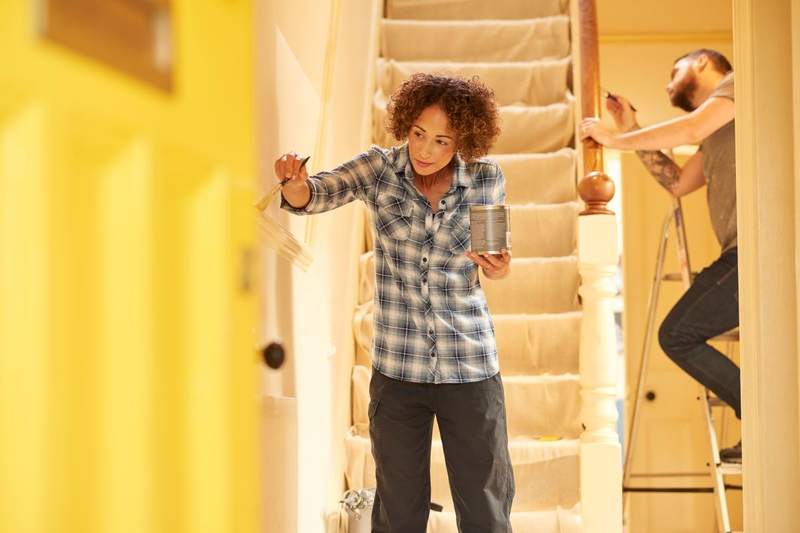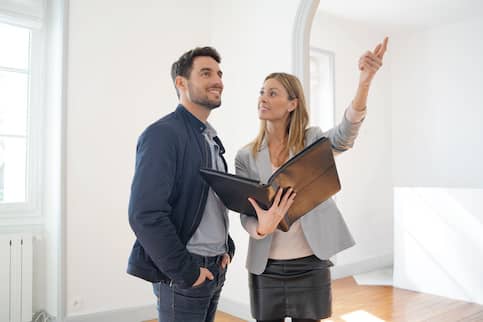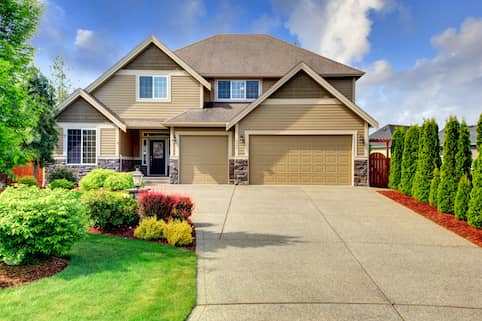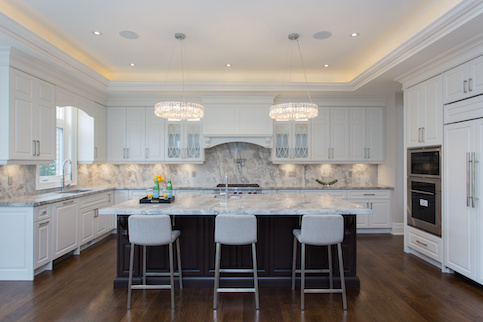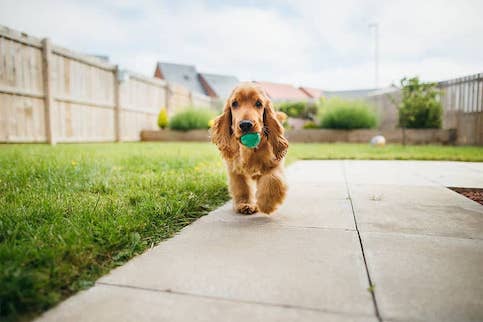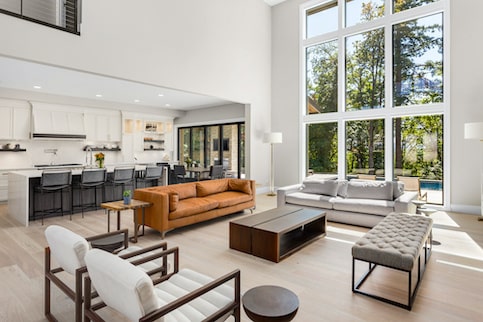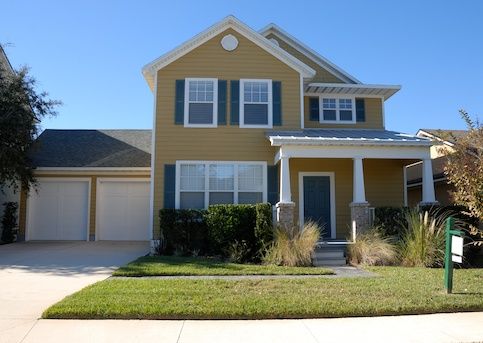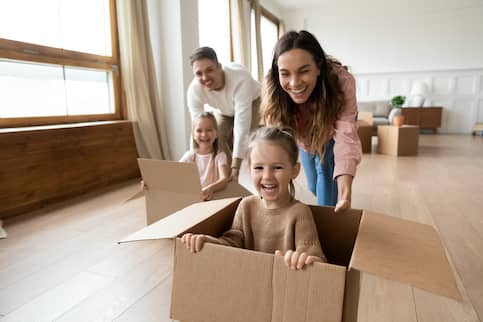Home improvements both big and small can add significant value to your property. A higher home value translates into more equity, which you can borrow. It also can help eliminate private mortgage insurance and make you more money when you sell. If you want to know how to increase home value, here are 40 home improvement ideas to get you started.
Key Takeaways:
- Home improvements can increase your home’s value and make it more pleasant to live in.
- Improvement projects can vary in scale, from cosmetic changes to major renovations.
- There are several ways you can pay for home improvements without breaking the bank.
1. Deep Clean Your Home
Cleaning your living space from top to bottom can dramatically improve its appearance. It may also help solve minor problems that could detract from your home’s value. Investing in a professional cleaning service may be worthwhile if you plan to show your home soon.
2. Paint The Exterior
An easy way to enhance your home’s curb appeal is to paint the exterior. A fresh coat of paint can cost anywhere from $1,800 to $13,000.
3. Spruce Up The Landscaping
Hiring a landscaper can boost your home’s curb appeal – and its value. According to the National Association of Realtors, a standard lawn care service can return more than double its cost.
4. Get Rid Of Clutter
Decluttering your property will increase its appeal to buyers, especially if you plan to sell soon. Yard sales, online marketplaces or groups that take donations can help you sell or give away items you no longer need. Consider storing things you still want or need out of sight. You can rent a storage unit if you don’t have space of your own.
What’s Your Goal?
Buy A Home
Discover mortgage options that fit your unique financial needs.

Refinance
Refinance your mortgage to have more money for what matters.
Tap Into Equity
Use your home’s equity and unlock cash to achieve your goals.
5. Remodel The Kitchen
While a kitchen remodel can be an expensive and invasive undertaking, kitchen upgrades can increase a home’s value between 38% and 96% of the amount spent on the remodel. If you can’t afford a full remodel, it’s still possible to enhance the appearance and functionality of your kitchen with less expensive improvements such as new cabinet facings.
6. Upgrade The Sink And Plumbing Fixtures
Replacing your kitchen sink will cost you between $216 and $628. Depending on the sink you choose and the plumbing work required, installation can add $380 to $1,400. Finally, you can expect to pay about $1,000 to replace the plumbing beneath the sink.
7. Replace Kitchen Cabinets
Older cabinets can make a kitchen look dated and deter potential home buyers. Freshen things up by replacing them. Semi-custom cabinets are less expensive than custom cabinets and range between $150 and $400 per linear foot, with an additional $3,000 to $8,500 for materials and installation. Custom cabinets range between $500 and $1,200 per linear foot, with an additional $12,500 to $18,000 for materials and installation.
8. Get New Countertops
Another way to spruce up a kitchen is to replace old, worn countertops. The price will vary depending on the material and size of the space, but you can expect new countertops to cost anywhere from $1,200 to $7,780.
9. Install Updated Appliances
Updated appliances make a kitchen feel more modern. Replacing an old refrigerator with a sleek new model can cost anywhere from $500 to $4,000. A new dishwasher typically costs between $300 and $1,200.
Ready To Refinance?
Get matched with a lender that can help you reach your financial goals.
10. Clean Or Replace The Carpets
If your carpets have seen better days, it might be time to replace them. New carpets will make the house look and feel new again. The average cost to replace the carpets in a 10-by-12-foot room can range from $360 to $1,320, while a 16-by-20-foot room can cost anywhere from $960 to $3,520 to carpet.
11. Refinish Or Replace The Flooring
If your floors have noticeable wear and tear, it might be time to update them or give them a fresh finish. Depending on the type of flooring you have, simply refinishing them may improve their appearance enormously. If new flooring is needed, some solutions may allow you to layer new flooring over your existing floors without breaking the bank. Replacing the floors typically costs between $7 and $25 per square foot. So, if you’re looking to replace the floors in a 500-square-foot space, you can expect it to cost between $3,500 and $12,500.
12. Upgrade The Windows
According to the U.S. Department of Energy, about 30% of a home’s heating is lost through windows. Installing energy-efficient windows can help you regulate the temperature of your home. In the winter, they can reduce or eliminate drafts and keep heat indoors. During the summer, they can keep in the cool air. Upgrading to energy-efficient windows can cost anywhere from $320 to $2,000.
13. Replace The Front Door
If your house is eye-catching, replacing the front door will entice more home buyers to look inside. Besides adding curb appeal, it can also increase energy efficiency. Replacing an entry door can cost between $450 and $1,700, depending on materials and the type of door you choose.
14. Install Or Upgrade An HVAC System
Installing or upgrading a heating, ventilation and air-conditioning system can be a significant investment, but it can pay off in a big way. Not only will a new HVAC system increase the value of your home, but it can save you money on utilities. Replacing a fossil-fuel furnace with an electric heating system for a 2,000-square-foot home costs an average of $18,800. That might seem pricey, but a new heating and cooling system can increase your property value by as much as 10%.
15. Redo Your Bathroom
If your budget and timeline are somewhat limited and you can only renovate one room, consider the bathroom. A bathroom remodel can significantly improve your home as a place to live and as an asset.
View Your Refinancing Options
Find a refinance lender that will work with your unique financial situation.
16. Install Low-Flow Toilets
Low-flow toilets are eco-friendly and use less water. They sell for as little as $100 or $200, but higher-end models cost up to $1,500, plus labor for installation.
17. Put In A Walk-In Shower
The cost of adding a walk-in shower depends on whether you’re converting an existing bathtub or installing one from scratch. Installing a prefab walk-in shower can cost $700 to $3,000, while a custom walk-in costs between $4,200 and $8,500. If you’re converting an existing tub, costs typically range from $1,200 to $8,000.
18. Upgrade The Vanities
Replacing a vanity can quickly freshen up a bathroom. The price can vary widely depending on the size and materials used, but typically, it will cost anywhere from $300 to $3,800.
19. Mount A New Bathroom Mirror
A new mirror can brighten up a space and make it feel larger. A bathroom mirror costs a couple of hundred dollars on average, depending on the frame material and size. Labor costs to replace a bathroom mirror typically range from $150 to $350, but installing a larger mirror can cost more.
20. Upgrade The Electrical System
Modernizing your home’s electrical system can make your home safer and more energy-efficient. The cost of wiring upgrades varies greatly depending on the size of the home and the extent of the job. It can cost as little as $1,100 or as much as $13,000, but rewiring a house costs roughly $7,000 on average.
21. Consider New Plumbing
If your home’s plumbing is aging and prone to leaks, it may be time to replace the pipes. Replacing an entire plumbing system in a 2,000-square-foot home can cost anywhere from $3,000 to $16,000.
22. Repair Or Replace The Roof
Roofs weather the elements to protect your home. They have an average life span of 30 years but can last longer, depending on the materials used. If it’s time for a replacement, you can expect to pay between $8,000 and $60,000 for a 2,000-square-foot roof, again depending on the materials. Asphalt shingles, for example, are less expensive than metal shingles. While these are high upfront costs, NAR reports that homeowners often recoup 100% of the value of a roof replacement.
23. Install Solar Power
Adding solar panels can take a bite out of future energy bills and make your home more attractive to potential buyers. The price of installing a solar energy system has actually dropped in recent years to around $25,000. There is also a federal tax credit of 30% that homeowners who install solar panels can take advantage of.
24. Make Sure Your Home Is Free Of Mold And Pests
Even if you’ve seen no evidence of pests or mold, it might be wise to get your home inspected. If you’re selling your home and the inspection discovers mold or pests, it can affect the sale price. A minor mold problem can cost $500 to $1,000 to fix, but mold affecting the entire home can cost up to $30,000 to remove.
25. Upgrade Interior Light Fixtures
New light fixtures literally can brighten up your home while adding character. A new light fixture can cost anywhere from $30 to over $1,000. If you need an electrician to install it, they typically charge $35 to $100 per hour.
26. Install Smart Technology
Small-scale changes such as using LED light bulbs and smart thermostats can help you better control your energy use and save you money on utilities. Automated functions can make the home easier to manage and more comfortable to live in, increasing its appeal to buyers.
27. Finish The Basement
A finished basement adds usable space to your home, boosting its value. You need to be prepared for the cost of materials, labor, drywall and permits. The average cost to finish a basement is roughly $22,850.
28. Put In A New Garage Door
A street-facing garage door can have a significant effect on your curb appeal. You can expect a new garage door to cost about $4,500, but you can typically recoup almost double the cost when you sell.
29. Replace The Siding
Siding gets worn down by the elements over time. Replacing it can give your home a fresh look. You can expect 1,250 square feet of vinyl siding to cost roughly $17,000 and the same amount of fiber-cement siding to cost over $20,000.
30. Add A Deck Or Patio
A deck or patio adds outdoor space to your home and gives you a place to entertain guests or relax. Decks cost anywhere from $17,600 to $24,000, while a concrete patio costs between $1,600 and $5,700.
31. Build An Outdoor Kitchen
An outdoor kitchen is another way you can better use your space to build a relaxing spot for entertaining guests. Building an outdoor kitchen costs between $6,000 and $26,000, depending on the type and quality of the appliances you choose.
32. Add A Firepit Or Fireplace
If you’re already planning on spending more time outside, you might also consider adding a firepit, which can typically be installed for under $1,000. On the other hand, if you want to make the interior of your home cozier, you can install a fireplace, which costs an average of $2,500.
33. Install An In-Ground Pool Or Hot Tub
If you’ve always dreamed of having a pool, you could make that dream come true with an in-ground pool or hot tub. However, it can be a substantial investment. Adding an in-ground pool costs an average of $35,000. Adding a hot tub will cost you an additional $6,000 to $15,000.
34. Add An Air Filter
Improving the air quality in a home can help increase its value and clear the house of unpleasant aromas. The Environmental Protection Agency encourages homeowners to increase ventilation by adding windows, removing indoor sources of pollution, and installing air filters.
35. Paint The Interior A Popular Color
There are many immediate benefits of this low-cost option that can refresh the appearance of your home, especially if you’re preparing to sell it. A 2023 Zillow study found that some buyers were offering more for homes with charcoal gray walls.
36. Add A Bonus Room
If you live in a smaller home, you can add to your home’s existing value and create more space by building an addition to the existing structure. Adding a bonus room typically costs between $80 to $200 per square foot.
37. Build An ADU
An alternative to building a bonus attached room is building an accessory dwelling unit – commonly referred to as an ADU or a mother-in-law suite. It’s a housing unit that’s usually separate from the main house, has its own entrance and kitchen, and can function as additional living space. A 500-square-foot ADU can cost anywhere from $50,000 to $150,000 to build.
38. Add An Energy-Efficient Washer And Dryer
Replacing your older washer and dryer with an energy-efficient pair can increase the value of your home and save on utilities. An energy-efficient washer and dryer set typically costs between $1,500 and $3,000.
39. Install Stone Veneer
Replacing vinyl with a manufactured stone veneer can give your house’s facade an elegant look. You can expect a 300-square-foot stone veneer to cost roughly $11,000.
40. Add A Parking Space
Do you have unused land next to your home that could be converted into a new parking space? This area could be leveled and paved for roughly $2,000 to $7,000. If you want to build a fully attached, covered garage, that’ll cost about $26,000.
How To Pay For Improvements That Add Value To Your Home
While some improvements are relatively easy to afford, others are expensive enough to require financing. While there are options such as a Fannie Mae HomeStyle Loan that let homeowners refinance and pay for renovations, borrowers have plenty of options for funding home upgrades.
Cash-Out Refinance
A cash-out refinance is when you take out a new mortgage based on your home’s current value, pay off your current loan, and keep the difference in cash. This lets you convert some of your equity into cash that you can use to pay for major expenses. You repay the equity you borrow as part of your new mortgage payment.
Home Equity Loan
A home equity loan is a second mortgage that uses your home equity as collateral. Paid to you in a lump sum, you make a monthly payment on the loan in addition to your primary mortgage payment. Home equity loans usually have a fixed interest rate.
Home Equity Line Of Credit
A home equity line of credit is a second mortgage where your equity is used to establish a line of credit you can borrow from as needed. This can be helpful if renovations go over budget or you plan multiple projects. HELOCs usually have adjustable interest rates.
Personal Loan
A personal loan is an unsecured loan that doesn’t require you to use your equity. As a result, you don’t risk losing your home if you can’t repay it. However, personal loans typically come with higher interest rates – usually as a fixed rate.
FAQ
Here are answers to some frequently asked questions about boosting the value of your home.
The Bottom Line
If you’re ready to sell your home, you may prefer to bypass making renovations. However, if you’d like to make as much as you can from the sale, a few home improvement projects may increase your property’s value and your profits.
More From Quicken Loans:
Emma Tomsich contributed to the reporting of this article.

Rory Arnold
Rory Arnold is a Los Angeles-based writer who has contributed to a variety of publications, including Quicken Loans, LowerMyBills, Ranker, Earth.com and JerseyDigs. He has also been quoted in The Atlantic. Rory received his Bachelor of Science in Media, Culture and Communication from New York University. He also completed the SoFi/Coursera Fundamentals of Personal Finance Specialization consisting of five courses: Introduction to Personal Finance, Saving Money for the Future, Managing Debt, Fundamentals of Investing, and Risk Management in Personal Finance.
